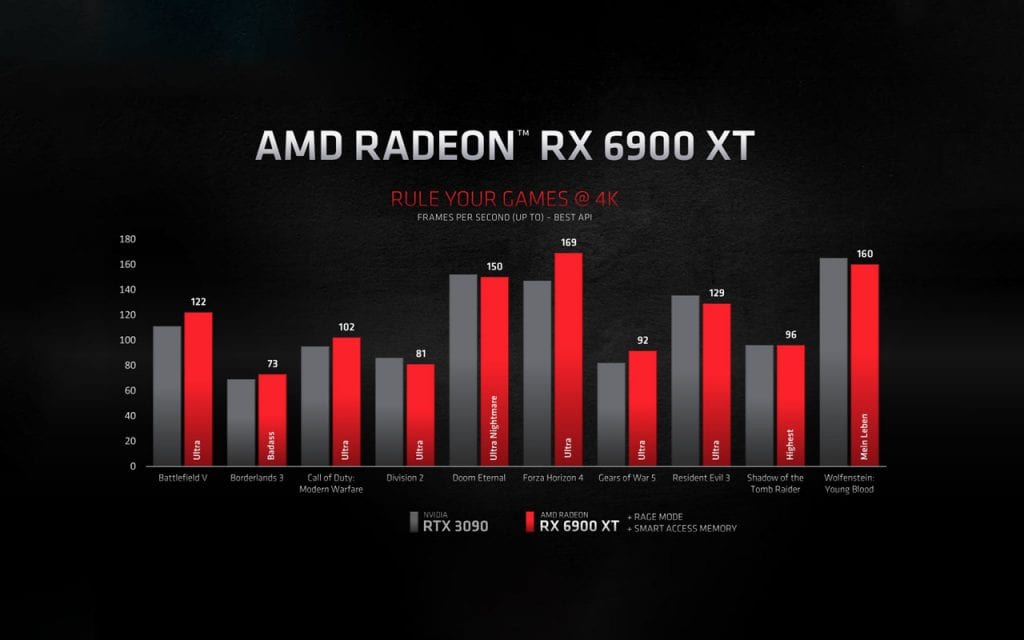Gamers the winners as graphics titans trade blows on price and performance.
It seemed to take forever, but we finally got to see what AMD has to offer with ‘Big Navi’ – codename for their name RDNA 2 GPU architecture – at a special virtual event this week.
Having got gamers the world over dribbling with excitement over their game-changing Ryzen 5000 CPU launch just a few weeks ago, expectations were higher than ever heading into the Radeon 6000 series GPUs reveal, and team red definitely didn’t disappoint, with specs that should deliver a major uplift in performance and put them right in line with Nvidia’s RTX 3000 series cards.
Three new SKUs were announced at the event – the Radeon RX 6900 XT at $999, 6800 XT for $649 and 6800 costing $579 (UK pricing has not been revealed yet). The 6800 cards will launch November 8th, with the big-boy big-navi 6900 card coming our way a little later on December 8th. Here’s the reveal video:
The Specs
| Radeon 6900 XT | Radeon 6800 XT | Radeon 6800 |
| Compute Units: 80 Ray Accelerators: 80 Game Frequency: Up to 2015 MHz Infinity Cache: 128 MB Max Memory Size: 16 GB Memory Type: GDDR6 | Compute Units: 72 Ray Accelerators: 72 Game Frequency: Up to 2015 MHz Infinity Cache: 128 MB Max Memory Size: 16 GB Memory Type: GDDR6 | Compute Units: 60 Ray Accelerators: 60 Game Frequency : Up to 1815 MHz Infinity Cache: 128 MB Max Memory Size: 16 GB Memory Type: GDDR6 |
The RDNA architecture has been re-tooled specifically with gamers in mind, featuring a bunch of enhancements that should accelerate performance whilst maintaining the same power requirements as last years cards.
One of the key drivers of this is the new Infinity Cache, which the company describes as “an all-new cache level that enables high bandwidth performance at low power and low latency. This global cache is seen by the entire graphics core, capturing temporal re-use and enabling data to be accessed instantaneously.” This promises an equivalent 3x bandwidth improvement over the previous generation, despite the cards sporting a perhaps lower than expected 256-bit bus. Impressive stuff.
DirectX raytracing now, DLSS later
The big features missing from last year’s AMD line-up was raytracing and an equivalent to Nvidia’s DLSS (Deep Learning Super Sampling) technologies. But no longer.
This time around, raytracing is fully supported at the hardware level, as the cards support Microsoft’s DirectX ray-tracing API, albeit in a different way to Nvidia. Whilst Nvidia RTX graphics cards use dedicated RT cores tasked only with computing rays, AMD has opted to include RA (Ray Accelerators) which are specialised hardware customisations, as part of every compute core on the die.
As for a DLSS equivalent (DLSS is Nvidia’s term for what is essentially a sophisticated upscaling technique), we’ll have to wait a bit longer to see what AMD have to offer here, as their own version isn’t ready for primetime yet. Bummer.
Even so, when it does arrive it shouldn’t require any new hardware for it to work, so expect it to be used extensively in the next-gen consoles, as they too are based on the new RDNA 2 architecture. An exciting prospect.
Performance
It’s very early days, but based on AMD’s own slides performance looks to be excellent in a multitude of modern titles, as both companies look evenly matched, trading wins in frame rates depending on the title. The pattern is consistent across 1440p and 4K resolutions.

The only caveats are where DLSS may have been used on the Nvidia benchmarks, which of course skews the picture somewhat, and where AMD has used special acceleration options – Rage mode and Smart Access Memory – only available should you also own a 5000 Ryzen series CPU with compatible 500 chipset motherboard.
Rage mode takes advantage of any overclocking headroom in the GPU to give a 1-2% performance boost (a very modest gain) but Smart Access Memory grants a significant boost by enabling faster data transfer speeds between the CPU and GPU. By pairing this efficient data transfer, smart access feature with the new 128MB Infinity Cache, it can help boost the throughput between the CPU and the GPU.
Based on the metrics seen so far, the Radeon 6800 is aimed at taking on the trusty old RTX 2080 Ti (and by extension, the new RTX 3070), the 6800 XT the RTX 3080 and finally, the 6900 XT taking on the monster RTX 3090.
Which brand should you buy? You best wait for a few weeks…
It may be very tempting to choose one of these exciting new cards now but seriously, don’t – you’re much better off waiting until they’re all out and have been properly put through their paces by the community, as only then when we have totally unbiased benchmarks can we properly judge them.
As for their core technologies, there’s a feeling that the new AMD cards won’t be as good at raytracing as Nvidia’s 3000 series, as among other things, team green is now on their 2nd proper generation of the technology. On the other hand, AMD GPUs can take advantage of pooling resources with a Ryzen 5000 series CPU and, in the case of each companies top-level card, the AMD Radeon 6900 XT is a third cheaper than the Nvidia equivalent the RTX 3090. At the bottom end, the RTX 3070 is $80 cheaper.
Whichever way you go though, you’ll be getting top-level performance-per-price-point no matter what. A true win-win for us all. Excelsior!







